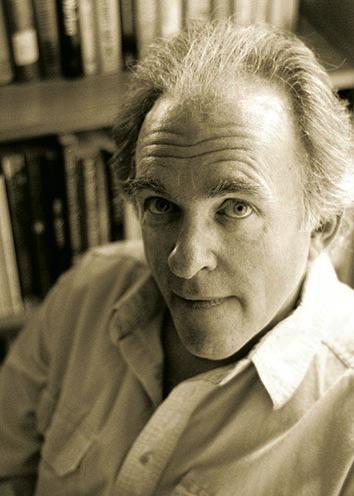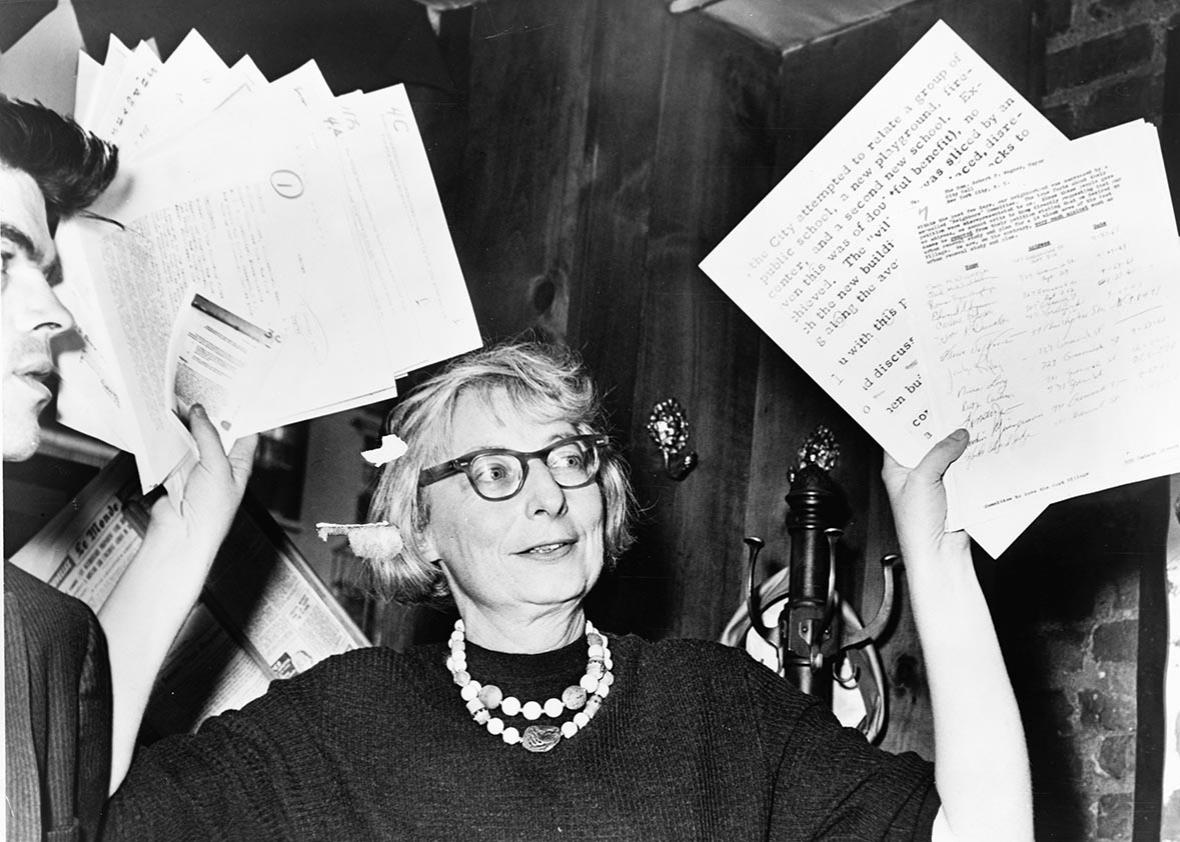The ’60s didn’t begin in 1960—or so the conventional history of the counterculture would have it. It wasn’t until 1964 and the Free Speech Movement at Berkeley, the story goes, that authority was seriously questioned. But tear your gaze away from those photogenic kids and consider these three books published in 1961, 1962, and 1963: The Death and Life of Great American Cities, Silent Spring, and The Feminine Mystique. All three books were written by women who were well beyond their college years, and all three transformed the world more lastingly than any protest. The third, by Betty Friedan, kicked off second-wave feminism. The second, by Rachel Carson, launched the environmental movement. And as for the first: If you have chosen an American city for your home, Jane Jacobs made the world you live in—although it might be more accurate to say that she saved it.
A new biography by Robert Kanigel, Eyes on the Street: The Life of Jane Jacobs, tries both to do justice to Jacobs’ ideas and to provide some kind of insight into the woman who formulated them. But where Jacobs’ writings tore down and reconstructed the way we understand cities, Kanigel never quite succeeds in digging down to his subject’s foundation.
That Jacobs’ principles, innovative at the time, seem so obvious to us now testifies to how thoroughly her thinking has permeated the contemporary view of urban life. She devoted a chapter to each of the four characteristics of a healthy city in Death and Life, summarized by Kanigel as: “1) mixed primary uses”—that is, combining residential, commercial, and “industrial” (or workplace) properties in the same neighborhood; “2) short blocks,” which, Jacobs believed, foster socializing on the street; “3) buildings of varied ages, including old ones”; and “4) dense concentrations of people.” At the time she wrote, however, city planners believed that cramped, crowded, dark, and dirty city neighborhoods fomented crime and other forms of social malaise. The best way to fix them, architectural modernists insisted, was to tear down the “slums” and build high-rise apartment complexes surrounded by wide-open green spaces, while moving shops, industry, and offices to dedicated parts of town. Like a finicky child who demands that every component of his meal be separated (surely it’s no coincidence that the heyday of this ideal coincided with the introduction of the subdivided frozen TV dinner), these experts firmly believed that the mixed-up chaos of city life was one of the things that made the people who lived there so unfortunate.
Today, the experts’ style of housing project has replaced, as the architectural emblem of social dysfunction, the “slums” they once decried. Jacobs argued that neighborhoods like the one she and her family lived in, in New York’s Greenwich Village, might look ramshackle and chaotic to outsiders but were in fact held together by “a marvelous order,” invisible to superficial observation. That order constellated around the street, where adults exchanged greetings and small talk; where children played; where shopkeepers, artisans, and service workers did their jobs. People looked out for one another. In the most famous passage in Death and Life, she described a day in the life of her own street, celebrating it as an “intricate ballet.” The projects city planners proposed to replace such neighborhoods were, by contrast, sterile and alienating, deprived of the community that knitted residents together, a community often rooted in small businesses. As Jacobs said in a sensation-causing speech made before a 1956 conference on urban design (she was filling in for a boss who couldn’t make it), “One supermarket can replace thirty neighborhood delicatessens, fruit stands, groceries, and butchers … but it cannot replace thirty storekeepers or even one.”
By 1958, Jacobs had published an article in Fortune, “Downtown Is for People,” constituting her first full-fledged attack on the urban planning establishment. (The article is included in a new collection of her shorter writings, Vital Little Plans.) A month after Jacobs handed in the manuscript for Death and Life in 1961, her own neighborhood was named an “urban renewal area,” meaning that 14 blocks of the “slum” she inhabited (including her own house at 555 Hudson St.) were slated to be torn down. Jacobs and her husband plunged into the ultimately successful Committee to Save the West Village. That battle, although less celebrated than the opposition she led to Robert Moses’ proposed eight-lane expressway across lower Manhattan (subject of not one but two books and a forthcoming opera), became the occasion for New York Planning Commission Chairman James Felt to criticize Jacobs’ insistence that only local residents could successfully improve a neighborhood and that the Village’s “mixture of land uses” was not a major cause of its “blight.” Underlying this view was the conviction that if cities could be made more like the suburbs, they’d become more wholesome.

Felix Rust
In hindsight, both Moses’ and Felt’s plans look insane. Even in 1961, the West Village was not a slum; having maintained its architectural character, it certainly isn’t now. For good and for ill, its residents succeeded so comprehensively in improving it that the neighborhood has now been overrun by celebrities and financiers. The storefront townhouse that Jacobs and her husband bought for about $7,000 sold for more than $3 million in 2009 and is certainly worth even more today. The local mom and pop stores Jacobs rhapsodized over have been supplanted by a different Jacobs, Marc, who seems intent on opening a high-end clothing shop on every block of West Fourth Street. The buildings are spruced up but more or less the same, yet the community that now occupies them no longer sits on the stoops to shoot the breeze with the corner hardware store owner. You never see kids playing on the street, though you might catch a glimpse of one being loaded into an Uber for delivery to a pricey private school uptown.
Jacobs was right about so many things that for the past few decades of her life (she died in 2006) she was treated as a sort of priestess of organic urbanism. Adam Gopnik, writing about her recently in the New Yorker, described her as “one of three people I have met in a lifetime of meeting people who had an aura of sainthood.” This, of course, has led to the understandable impulse to accentuate her shortcomings and mistakes. Such an uneasy mixture of idolatry and contrarianism makes for a tricky task for the biographer. Most of the people who read Eyes on the Street will be Jacobs fans, but given that they prize her for her iconoclasm, a mere hagiography would not do.
Kanigel attempts to square this circle by adopting a jocular, conversational tone, presumably in imitation of Jacobs’ own plain speaking. “Now, it’s fair to ask: Was she always like this?” is how he starts one paragraph. This is not a success, although I’m not sure it rises to the level of “infantilizing,” as one critic has found it. (Impertinent is more like it.) Eyes on the Street is haunted by the impression that Jacobs has gotten the better of her biographer, who finds her “perfectly normal, healthy and happy in all the important ways.” She does present a challenge to anyone inclined to explain her scrappy temperament as rooted in deep or hidden wounds. Her parents were admirably supportive, providing a family environment that encouraged all four of their children to think for themselves. Her husband of 52 years, an architect, loved her on first sight (they married two months after they met) and happily played second banana to her for the rest of his life. Her own kids turned out great.
Furthermore, Jacobs seems to have been constitutionally averse to introspection. She didn’t keep a diary and “I never heard her reflecting on herself,” her cousin told Kanigel. A friend who confided her own history of clinical depression found Jacobs an uncomprehending and therefore unsympathetic listener. It’s no wonder that Kanigel can’t seem to get beneath Jacobs’ skin, which was, by her own admission, “fairly thick.” Despite the ostentatious familiarity of the book’s tone, his subject remains always at arm’s length. Could a more shrewd and intuitive writer found a way beneath this surface?
The Jacobs of Eyes on the Street is the quintessential man of action, except for the “man” part. She remains one of the few 20th-century female intellectuals whose personal struggles play next to no role in her public image. Even Jacobs’ identity as a mother became something to brandish against the New York City planners who proposed running a thoroughfare through Washington Square Park, where her children had played with so many other women’s kids. Mothers could be viewed as meddling amateurs in the realm of neighborhood design–that’s how Moses thought of them, raging that everybody loved his highway scheme except for “a bunch of mothers”—or they could be cast as practical, experienced, and commonsensical, unlike the overeducated, out-of-touch “experts” at City Hall. Jacobs knew how to work that angle, making an advantage out of what might have been a liability.
When it comes time for his account of her masterpiece, Death and Life, Kanigel announces that she was “a writer, but of a different kind, one that scarcely had a name”; her task was not to demonstrate a specialized expertise but “to take almost anything in the great universe of people, places, and ideas, scientific and human, current and historical, and make fresh lively sense of it.” There of course is a name for this kind of writer: journalist. Jacobs had been working as a feature journalist for a couple of decades by the time she wrote Death and Life. Betty Friedan and Rachel Carson had similar gigs prior to writing their seminal books. Their position as journalists, women, and skeptics, excluded from the expert class, became, paradoxically, a form of authority.
Another thing journalists learn to do is leave stuff out. Friedan wrote as if middle-class homemakers were the only women in America, and Jacobs, in trumpeting the self-organizing genius of working-class urban neighborhoods, skirted the inflammatory subject of exclusion and race. That doesn’t make what either woman wrote incorrect, only incomplete. Is it Jacobs’ fault that her acolytes tend to see her as issuing the last word on every dilemma confronting city-lovers? She did become a bit oracular toward the end, but she also followed up Death and Life with The Economy of Cities, a book elaborating on her conviction that, when it comes to urban economies, there are no causes of stagnation—it just happens, naturally—only causes of growth.
By “growth,” Jacobs didn’t mean share prices or market share, but an evolved, resilient, resourceful economy, full of both small and large businesses. Cities must always be changing. In that light, does it really make sense to mourn the loss of Jane Jacobs’ Greenwich Village? The rich do have a habit of chasing all the interesting people out of a neighborhood, but what really matters is the interesting people, and once chased out they have to go somewhere. Jane Jacobs helped make city life cool again in the age of suburbs, ushering in an era when 80 percent of Americans live in urban areas. Instead of choosing between the city and suburbs, most of us now choose between cities, or even between neighborhoods within cities. The intricate ballet has packed up and moved on from Jacobs’ Village, but it’s still playing somewhere, if you know how to look.
—
Eyes on the Street: The Life of Jane Jacobs by Robert Kanigel. Knopf.
Vital Little Plans: The Short Work of Jane Jacobs edited by Samuel Zipp and Nathan Storring. Random House.
Read the rest of the pieces in the Slate Book Review.
